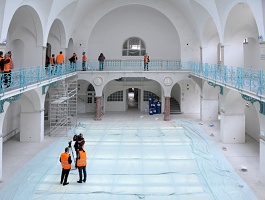
Liberec has reopened the renovated municipal baths to the public for the second time
 |
The municipal baths are among the most valuable monuments in Liberec. They were built between 1900 and 1902 according to a design by Viennese architect Peter Paul Brang. The baths form an architecturally unique complex alongside the neighboring North Bohemian Museum and the children's polyclinic. However, since 1984, they have not served their original purpose, and the building, which changed owners several times, gradually fell into disrepair. In 2005, the city of Liberec purchased the baths for nine million crowns to prevent their deterioration. "The most urgent repairs and preservation of the building required an investment of 27.5 million crowns at that time," Minstrová said.
The reconstruction of the baths into a gallery object began on September 9, 2011, and lasted 20 months. The project included not only the renovation of the historical building but also the construction of facilities and a modern depository nearby. The total cost was 360 million crowns, with 85 percent covered by European funds, and the remaining 15 percent paid by the Liberec Region. The modern depository next door has sparked discussions, but it also references the history of the baths. "The waves on the dark gray façade are replicas of a pattern that was used to print textiles at the beginning of the 20th century, and the motif also serves as a reminder that a stream flows here,” Minstrová stated.
During the reconstruction, builders tried to preserve as many original elements as possible. Under the unappealing tiles, they discovered original columns and stone cladding, while the original metal railings, stained glass windows, as well as some doors and windows were restored and completed. In places, Art Nouveau ceramic tiles and inscriptions recalling the original use of the baths have been preserved. On the columns in the gallery of the former pool hall, inscriptions like "Squeeze swimsuits into drains," which recall the original purpose of the building, remained even after cleaning. "It had its charm; we used to love coming here, but it probably wouldn't make much sense to restore the baths today," noted an older woman who came for the tour with her grandson.
The English translation is powered by AI tool. Switch to Czech to view the original text source.
0 comments
add comment
Related articles
0
13.02.2020 | The Liberec Region took over the municipal baths building with a gallery from the city
0
18.09.2014 | The Building of the Year in the Liberec Region is the renovated spa in Liberec
0
21.11.2013 | The relocation of the gallery to the spa building will cost the Liberec Region 85 million CZK
0
15.10.2012 | I druhý posudek ukázal, že oprava lázní v Liberci je předražená
0
23.02.2012 | The reconstruction of the Liberec spa will be more expensive, they forgot about the interior
0
09.09.2011 | In Liberec, the second of the controversial contracts has begun - the renovation of the spa











